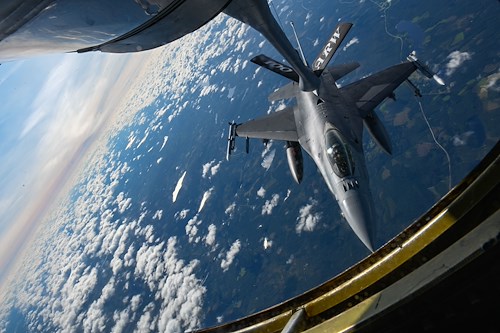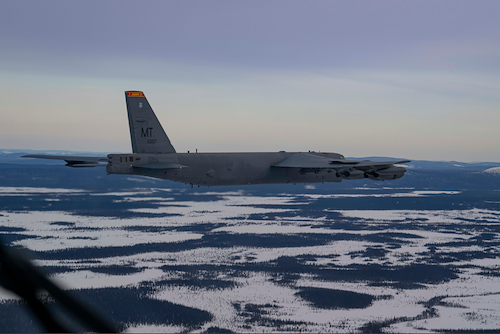Gallery contains 2 images
×
Photo 1 of 2
NKAWTG: Fuel the Fight
A U.S. Air Force F-16 Fighting Falcon from the 52nd Fighter Wing, Spangdahlem Air Base, Germany, receives air-to-air refueling from a KC-135 Stratotanker from the 100th Air Refueling Wing, Royal Air Force Mildenhall, England, in support of Astral Knight 23 Part 6 over Finland, Aug. 24, 2023. AK23-6 has furthered U.S. Air Forces in Europe’s ability to operate from locations with varying levels of capacity and support while ensuring Airmen and aircrews are postured to respond across the spectrum of conflict. (U.S. Air Force photo by Staff Sgt. Jesenia Landaverde)
Photo by: U.S. European Command Public Affairs
Photo 2 of 2
U.S. Army Europe and Africa
The 5th Battalion, 7th Air Defense Artillery’s U.S. Army Patriot Missile Systems arrived in Croatia May 17, 2021 to participate in DEFENDER-Europe 21 associated exercise Astral Knight 21 and exercise Immediate Response 21. The systems completed their journey after a day-long convoy of 50 vehicles through Slovenia into Croatia. The Regiment is participating in a series of combined exercises with multiple NATO allied and partner forces as part of DEFENDER-Europe 21. The exercises increase interoperability with host nation forces and demonstrate the battlefield capabilities of 5-7 ADA. The systems were displayed for Croatian forces and local media outlets to get an introduction to the Patriot systems. The 5-7 ADA employed the systems during DEFENDER-Europe 21, a large-scale U.S. Army-led exercise designed to build readiness and interoperability between U.S., NATO allies and partner militaries. This year more than 28,000 multinational forces from 26 nations will conduct nearly simultaneous operations across more than 30 training areas in more than a dozen countries from the Baltics to the strategically important Balkans and Black Sea Region. Follow the latest news and information about DEFENDER-Europe 21, visit www.EuropeAfrica.army.mil/DefenderEurope. (U.S. Army photo by Sgt. Alexandra Shea)
Photo by: Sgt. Alexandra Shea
A multi-national military exercise, called Astral Knight 2024, kicked off Monday, in Europe. It is focused on exercising Integrated Air and Missile Defense (IAMD) and the incremental development of theater-wide security capabilities.
The exercise, slated to run through May 18, is U.S. European Command’s capstone IAMD exercise and falls under the Department of Defense’s broader exercise program called Large Scale Global Exercise 2024.
AK24 is scheduled to host nearly 5,000 Allied personnel from six participating Allied nations and more than 50 aircraft. Four Allied nations will provide aircraft for the exercise: Lithuania, Poland, the U.K. and the U.S. Other participating nations include Denmark and Greece, which will observe elements of the exercise, advancing Allied interoperability throughout the Baltic regions.
"Astral Knight demonstrates the collective defense capabilities of NATO Allies and partners across Europe," said Gen. James Hecker, U.S. Air Forces in Europe – Air Forces Africa and NATO Allied Air Command commander. “By fostering early collaboration and integration in air and missile defense efforts among USAFE-AFAFRICA and NATO nations, we enhance our ability to deter and respond effectively to shared threats.”
On top of safeguarding NATO sovereignty, IAMD involves a coordinated approach to protect Allied military forces and critical assets from air and missile attacks, ensuring they can operate freely, without disruption and impediment from enemy air and missile strikes. Recent conflicts, such as those in Ukraine and Israel, have highlighted the importance of quickly detecting and responding to aerial threats, such as missiles or drones.
IAMD is likened to a highly effective immune system in the human body. Just as the body’s immune system detects, identifies, and neutralizes foreign invaders, such as viruses and bacteria, IAMD leverages technology to detect, track, and destroy incoming airborne threats such as missiles and drones.
USAFE-AFAFRICA has enhanced IAMD systems by incorporating offensive and defensive measures across multiple components to create a comprehensive Allied force, capable of preventing an enemy from successfully employing offensive air and missile weapons to attack NATO sovereignty.
USAFE-AFAFRICA adopts a multi-layered, multi-domain defense design to effectively counter various threats. This is done both passively -- with measures including camouflage, concealment, and deception -- and actively, by integrating multiple air and missile kinetic and non-kinetic defense systems, such as defensive counter air, Patriot, Terminal High Altitude Area Defense, Aegis, and European-based assets.
The final layer of IAMD is Air Base Air Defense (ABAD), which recognizes the importance of protecting Allied bases from attacks. The defense of main operating bases, such as Ramstein Air Base, requires officials to consider and be prepared to defend against evolving capabilities including the proliferation of cruise missiles and drones. ABAD prioritizes the need to continually improve how NATO Allies defend their main operating bases against today’s threats.
“Recent events show our most probable threats today and in the foreseeable future could target our main operating bases, making IAMD and ABAD that much more important,” said James Shaw, USAFE-AFAFRICA’s Integrated Air and Missile Defense deputy division chief. “It’s critical to recognize 360-degree threats reach from beyond the borders all the way back to our air bases, which are key to generating combat power for the NATO Alliance and our nation.”
If a main operating base is likened to a castle, then ABAD signifies the defending walls and fortifications surrounding the castle. Before ABAD, these walls didn’t always exist. Now, ABAD provides local commanders the ability to defend their bases against these direct aerial threats.
ABAD is ultimately about self-defense.
During the USAFE-AFAFRICA-led IAMD exercise, participating nations will focus on enhancing movement, maneuverability, and integration between U.S. forces, NATO Allies and other partners, while practicing critical elements in USAFE-AFAFRICA's agile combat employment strategy.
USAFE-AFAFRICA has invested in advanced sensors, radars, and surveillance technologies, and integrated them with Allies and partners to develop a comprehensive and accurate common situational awareness picture. Such capabilities allow for effective detection, tracking and identification of potentially hostile airborne and missile threats.
Collaboration with NATO Allies, as in AK24, strengthens collective defense capabilities across the European theater and allow the U.S. and Allies to test command and control relationships. Through early collaboration and integration of Allied air and missile defense efforts, USAFE-AFAFRICA and NATO nations effectively deter and respond to threats.
AK24 will include live-fly and combat operations focused in Poland and the Baltic countries.
Find publicly releasable and photo, video and print products relating to AK 24 on the Defense Visual Information Distribution Service. Interested individuals are encouraged to subscribe to the AK24 DVIDS’ page to receive notifications on newly published content and material.











